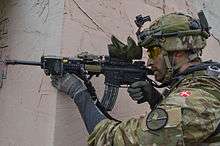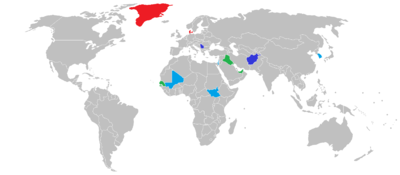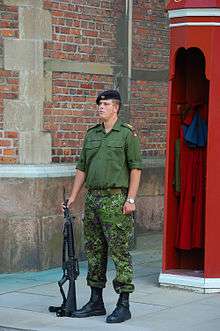Danish Defence
| Danish Defence | |
|---|---|
| Forsvaret | |
 | |
| Motto | Fordi noget er værd at kæmpe for! (Because some things are worth fighting for!) |
| Founded | 1949 |
| Current form | Defence Agreement 2013-17 |
| Service branches |
Royal Danish Army |
| Headquarters | Kuglegården |
| Website |
Official Website Official Facebook Official Picture Database |
| Leadership | |
| Monarch | Margrethe II |
| Prime Minister | Lars Løkke Rasmussen |
| Minister of Defence | Claus Hjort Frederiksen |
| Chief of Defence | General Bjørn Bisserup |
| Manpower | |
| Military age | 18 |
| Conscription | Yes, for males |
| Available for military service | 1,276,087 (2004 est.), age 18-60 |
| Fit for military service | 1,088,751 (2004 est.), age 18-60 |
| Reaching military age annually | 43.073[1] |
| Active personnel | 15,034 military and 4,877 civilian (1 January 2016)[2] |
| Reserve personnel | 12,000 + 51,000 volunteers in the Home Guard |
| Deployed personnel | 473 (21 January 2015)[3] |
| Expenditures | |
| Budget | 20.9 billion DKK (USD ~3.0 billion) (2015)[4] |
| Percent of GDP | 1,3% (2014) |
| Industry | |
| Foreign suppliers |
|
| Related articles | |
| History | Military history of Denmark |
| Ranks |
Officer ranks Other ranks |

The Danish Defence (Danish: Forsvaret, Faroese: Danska verjan) is the unified armed forces of the Kingdom of Denmark, charged with the defence of Denmark and its constituent, self-governing nations Greenland and the Faroe Islands.
The Queen is the Commander-in-chief in accordance with the Danish constitution, and under the Danish Defence Law[5] the Minister of Defence serves as the commander of the Danish Defence (through the Chief of Defence and the Defence Command) and the Danish Home Guard (through the Home Guard Command). De facto the Danish Cabinet is the commanding authority of the Defence, though it cannot mobilize the armed forces, for purposes that are not strictly defence oriented, without the consent of parliament.
Denmark also has a concept of "total defence" (Danish: Totalforsvar).[6]
History
After World War II, the different branches were reorganized, and collected under Danish Defence. This was to ensure a unified command when conducting joint operations, as learned from the war.[7]
Cold War
Total defence
Total Defence (Danish: Totalforsvaret), is a collection of the military, Home Guard, Danish Emergency Management Agency and elements of the police to ensure effective and coordinated efforts, in cases of crises, disasters or major incidents.[8]
Purpose and task
The purpose and task of the armed forces of Denmark is defined in Law no. 122 of February 27, 2001 and in force since March 1, 2001. It defines three purposes and six tasks.
Its primary purpose is to prevent conflicts and war, preserve the sovereignty of Denmark, secure the continuing existence and integrity of the independent Kingdom of Denmark and further a peaceful development in the world with respect to human rights.
Its primary tasks are: NATO participation in accordance with the strategy of the alliance, detect and repel any sovereignty violation of Danish territory (including Greenland and the Faroe Islands), defence cooperation with non-NATO members, especially Central and East European countries, international missions in the area of conflict prevention, crises-control, humanitarian, peacemaking, peacekeeping, participation in Total Defence in cooperation with civilian resources and finally maintenance of a sizable force to execute these tasks at all times.
Defence budget
Since 1988, Danish defence budgets and security policy have been set by multi-year agreements supported by a wide parliamentary majority including government and opposition parties. However, public opposition to increases in defence spending—during a period when economic constraints require reduced spending for social welfare—has created differences among the political parties regarding a broadly acceptable level of new defence expenditure.
The latest Defence agreement ("Defence agreement 2005–2009") was signed June 10, 2004, and calls for a significant re-construction of the entire military. From now about 60% support structure and 40% combat operational capability, it is to be 40% support structure and 60% combat operational capability, i.e. more combat soldiers and fewer "paper"-soldiers. The reaction speed is increased, with an entire brigade on standby readiness; the military retains the capability to continually deploy 2,000 soldiers in international service or 5,000 over a short time span. The standard mandatory conscription is modified. Generally this means fewer conscripts, less service time for them and only those who choose so, will continue into the reaction force system.
Expenditures
In 2006 the Danish military budget was the fifth largest single portion of the Danish Government's total budget, significantly less than that of the Ministry of Social Affairs (~110 billion DKK), Ministry of Employment (~67 billion DKK), Ministry of the Interior and Health (~66 billion DKK) and Ministry of Education (~30 billion DKK) and only slightly larger than that of the Ministry of Science, Technology and Innovation (~14 billion DKK). This list lists the complete expenditures for the Danish Ministry of Defence.
The Danish Defence Force, counting all branches and all departments, itself has an income equal to about 1–5% of its expenditures, depending on the year. They are not deducted in this listing.
Approximately 95% of the budget goes directly to running the Danish military including the Home guard. Depending on year, 50–53% accounts for payment to personnel, roughly 14–21% on acquiring new material, 2–8% for larger ships, building projects or infrastructure and about 24–27% on other items, including purchasing of goods, renting, maintenance, services and taxes.
The remaining 5% is special expenditures to NATO, branch shared expenditures, special services and civil structures, here in including running the Danish Maritime Safety Administration, Danish national rescue preparedness and the Administration of Conscientious Objectors (Militærnægteradministrationen).
Danish Defence expenditures (1949–1989)[9][10]
| 1940s | 1950s | 1960s | 1970s | 1980s | |||||||||||||||||||||||||||||||||||||
|---|---|---|---|---|---|---|---|---|---|---|---|---|---|---|---|---|---|---|---|---|---|---|---|---|---|---|---|---|---|---|---|---|---|---|---|---|---|---|---|---|---|
| 49 | 50 | 51 | 52 | 53 | 54 | 55 | 56 | 57 | 58 | 59 | 60 | 61 | 62 | 63 | 64 | 65 | 66 | 67 | 68 | 69 | 70 | 71 | 72 | 73 | 74 | 75 | 76 | 77 | 78 | 79 | 80 | 81 | 82 | 83 | 84 | 85 | 86 | 87 | 88 | 89 | |
| Total Budget (Billions) Kr. | 0.36 | 0.36 | 0.48 | 0.68 | 0.89 | 0.89 | 0.92 | 0.94 | 1.01 | 0.99 | 0.99 | 1.11 | 1.18 | 1.55 | 1.65 | 1.76 | 1.97 | 2.08 | 2.25 | 2.60 | 2.64 | 2.97 | 3.20 | 3.39 | 3.52 | 4.46 | 5.36 | 5.71 | 6.38 | 7.29 | 8.05 | 9.12 | 10.30 | 11.67 | 12.57 | 13.05 | 13.34 | 13.33 | 14.65 | 15.62 | 15.96 |
| Percentage of GNP | 2.0 | 1.7 | 2.1 | 2.7 | 3.4 | 3.2 | 3.2 | 3.0 | 3.1 | 2.9 | 2.6 | 2.7 | 1.6 | 3.0 | 3.0 | 2.8 | 2.8 | 2.6 | 2.6 | 2.7 | 2.4 | 2.4 | 2.4 | 2.2 | 2.0 | 2.2 | 2.4 | 2.2 | 2.2 | 2.3 | 2.3 | 2.4 | 2.4 | 2.4 | 2.4 | 2.2 | 2.1 | 1.9 | 2.0 | 2.1 | 2.0 |
| Defense Spending % Change | -0.3 | +0.4 | +0.6 | +0.7 | -0.2 | 0.0 | -0.2 | +0.1 | -0.2 | -0.3 | +0.1 | -0.9 | +1.4 | 0.0 | -0.2 | 0.0 | -0.2 | 0.0 | +0.1 | -0.3 | 0.0 | 0.0 | -0.2 | -0.2 | +0.2 | +0.2 | -0.2 | 0.0 | +0.1 | 0.0 | +0.1 | 0.0 | 0.0 | 0.0 | -0.2 | -0.1 | -0.2 | +0.1 | +0.1 | -0.1 | |
Danish Defence expenditures (1990–)[9][10]
| 1990s | 2000s | 2010s | ||||||||||||||||||||||||||
|---|---|---|---|---|---|---|---|---|---|---|---|---|---|---|---|---|---|---|---|---|---|---|---|---|---|---|---|---|
| 90 | 91 | 92 | 93 | 94 | 95 | 96 | 97 | 98 | 99 | 00 | 01 | 02 | 03 | 04 | 05 | 06 | 07 | 08 | 09 | 10 | 11 | 12 | 13 | 14 | 15 | 16 | 17 | |
| Total Budget (Billions) Kr. | 16.4 | 17.09 | 17.13 | 17.39 | 17.29 | 17.47 | 17.90 | 18.52 | 19.07 | 19.43 | 19.34 | 21.02 | 21.27 | 21.08 | 21.44 | 20.80 | 23.17 | 22.73 | 24.41 | 23.25 | 25.33 | 24.26 | 25.62 | 23.72 | 25.02 | |||
| Percentage of GNP | 2.0 | 2.0 | 1.9 | 1.9 | 1.8 | 1.7 | 1.7 | 1.6 | 1.6 | 1.6 | 1.5 | 1.6 | 1.5 | 1.5 | 1.5 | 1.3 | 1.4 | 1.3 | 1.4 | 1.4 | 1.4 | 1.4 | 1.4 | 1.3 | 1.3 | |||
| Defense Spending % Change | 0.0 | 0.0 | -0.1 | 0.0 | -0.1 | -0.1 | 0.0 | -0.1 | 0.0. | 0.0 | -0.1 | +0.1 | -0.1 | 0.0. | 0.0 | -0.2 | +0.1 | -0.1 | +0.1 | 0.0 | 0.0 | 0.0 | 0.0 | -0.1 | 0.0 | |||
Because Denmark has a small and highly specialized military industry, the vast majority of the Danish Defence's equipment is imported from NATO and the Nordic countries.[11]
Branches
- Royal Danish Army—Hæren (HRN)
 Royal Danish Navy—Søværnet (SVN)
Royal Danish Navy—Søværnet (SVN) Royal Danish Air Force—Flyvevåbnet (FLV)
Royal Danish Air Force—Flyvevåbnet (FLV) Danish Home Guard—Hjemmeværnet (HJV)
Danish Home Guard—Hjemmeværnet (HJV)
Structure
- Ministry of Defence ((in Danish): Forsvarsministeriet (FMN))
- Defence Command ((in Danish): Værnsfælles Forsvarskommando (VFK))
- Army Staff ((in Danish): Hærstaben (HST))
- Naval Staff ((in Danish): Marinestaben (MST))
- Air Staff ((in Danish): Flyverstaben (FST))
- Plans, Policy and Coordination Staff ((in Danish): Udviklings- og koordinationsstaben)
- Joint Operations Staff ((in Danish): Operationsstaben)
- Special Operations Command ((in Danish): Specialoperationskommandoen (SOKOM))
- Joint Arctic Command ((in Danish): Arktisk Kommando (AKO))
- Royal Danish Defence College ((in Danish): Forsvarsakademiet (FAK))
- Danish Armed Forces Health Services ((in Danish): Forsvarets Sundhedstjeneste (FSU))
- Danish Defence Acquisition and Logistics Organization ((in Danish): Forsvarsministeriets Materiel- og Indkøbsstyrelse (FMI))
- Danish Defence IT Agency ((in Danish): Forsvarets Koncernfælles Informatiktjeneste (FKIT))
- Danish Defence Personnel Organisation ((in Danish): Forsvarsministeriets Personalestyrelse (FPS))
- Danish Defence Estates and Infrastructure Organisation ((in Danish): Forsvarsministeriets Ejendomsstyrelse (FES))
- Home Guard Command ((in Danish): Hjemmeværnskommandoen (HJK))
- Defence Intelligence Service ((in Danish): Forsvarets Efterretningstjeneste (FE))
- Judge Advocate Corps ((in Danish): Forsvarets Auditørkorps (FAUK))
- Defence Financial Management Agency ((in Danish): Forsvarsministeriets Regnskabsstyrelse (FRS))
- Defence Internal Auditor ((in Danish): Forsvarets Interne Revision (FIR))
- Emergency Management Agency ((in Danish): Beredskabsstyrelsen (BRS))
- Administration of Conscientious Objector ((in Danish): Militærnægteradministrationen (MNA))
- Defence Command ((in Danish): Værnsfælles Forsvarskommando (VFK))
Special forces
- Jægerkorpset: Ground based infiltration unit.
- Frømandskorpset: Amphibious attack and infiltration unit.
- Slædepatruljen Sirius: Arctic dog sled unit patrolling the eastern border of Greenland.
Operations

Current deployment of Danish forces, since 10-03-2016:[12]
NATO
- A Challenger CL-604 MMA for maritime patrol in the Baltic Sea as part of NATO Allied Maritime Command.
- 35 soldiers in Kosovo participating in NATO's Kosovo Force, guarding the French Camp Marechal De Lattre de Tassigny.
- 97 people in Afghanistan as part of Resolute Support Mission.
- HDMS Absalon patrolling the Aegean Sea for human trafficking (September 2016).[13]
UN
- 20 people in Bamako and Gao, as part of MINUSMA.
- 13 people in Juba, as part of UNMISS.
- 11 people in Israel, as part of UNTSO.
- 2 people in South Korea, as part of UNCMAC.
National Missions
- 12 men on the Sirus Patrol of Eastern Greenland.
- A Challenger CL-604 MMA to fly patrol over Greenland.
- Rota between HDMS Tulugaq, HDMS Knud Rasmussen, HDMS Triton and HDMS Thetis to enact sovereignty patrol in the seas of Greenland and Faroe Islands.
- A Challenger CL-604 MMA to do maritime environmental monitoring missions in the North Sea.
Coalitions
- 149 people at Al Asad Airbase in Iraq to train the local military as part of Operation Inherent Resolve.
- 8 people operating radars as part of the radar element in Operation Inherent Resolve.
- 20 people in UAE as part of the operator element in Operation Inherent Resolve.
- Unknown number of Danish special forces in Senegal to train the local special forces as part of Flintlock 2016.[14]
Conscription

Technically all Danish 18-year-old males are conscripts (37,897 in 2010, of whom 53% were considered suitable for duty).[15] Due to the large number of volunteers, 96-99% of the number required in the past three years,[16] the number of men actually called up is relatively low (4200 in 2012). There were additionally 567 female volunteers in 2010, who pass training on "conscript-like" conditions.[17]
Conscripts in the Danish Defence (army, navy and air force) generally serve four months,[18][19] except:
- Conscripts of the Guard Hussar Regiment Mounted Squadron serve 12 months.
- Conscripts aboard the Royal Yacht Dannebrog serve nine months.[20]
- Conscripts in the Danish Emergency Management Agency serve nine months.[21]
- Conscripts in the Royal Life Guards serve eight months.
There has been a right of conscientious objection since 1917.[22]
See also
- Military history of Denmark
- Military of Greenland
- NATO
- Scandinavian defence union
- Officers ranks, Denmark
References
- ↑ "Statistik - oktober 2015". Statistik - oktober 2015.
- ↑ "Number of employees". forpers.dk (in Danish). Danish Defence. Retrieved 7 March 2016.
- ↑ "FN missioner med dansk deltagelse". forsvaret.dk. Archived from the original on 2015-11-23.
- ↑ "Defence expenditure". Retrieved 5 November 2015.
- ↑ "LOV nr 122 af 27/02/2001 om forsvarets formål, opgaver og organisation m.v." (in Danish). Retrieved 2012-07-30.
- ↑ "The Danish Defence Agreement 2005 - 2009". Danish Defence. Defence Command Denmark. 2009. Archived from the original on 2009-04-15. Retrieved 2009-05-12.
- ↑ Danish Defence (3 February 2014). "Danish Defence's History". forsvaret.dk (in Danish). Retrieved 21 December 2016.
- ↑ Ministry of Defence (6 April 2016). "Society's Overall Emergency (Total Defence)". fmn.dk (in Danish). Retrieved 21 December 2016.
- 1 2 ("Økonomi-styrelsen") ( Finance law 1996 to 2006])
- 1 2 (1976–1989)
- ↑ Jens Ringsmose (November 2007). "Danmarks NATO omdømme" (PDF). cms.polsci.ku.dk. Dansk Institut for Militære Studier.
- ↑ "Danish Defence around the world right now". forsvaret.dk (in Danish). Forsvaret. Retrieved 6 March 2016.
- ↑ Ussing, Jakob. "Absalon to be part of NATO fight against human trafficking". b.dk (in Danish). Berlinske. Retrieved 6 March 2016.
- ↑ Lindhardt, Søren. "Special Forces training Nigerian special forces". forsvaret.dk (in Danish). Defence Command. Retrieved 21 March 2016.
- ↑ Statistical information from the draft board (in Danish)
- ↑ Thomas Klose Jensen. "Frivillig værnepligtig: Det er min drengedrøm". DR.
- ↑ Ordinary conscript (in Danish)
- ↑ Army's basic training (in Danish)
- ↑ Air force's basic training (in Danish)
- ↑ Navy's basic training (in Danish)
- ↑ Conscription in the Danish Emergency Management Agency (in Danish)
- ↑ Alternative service law, 13 December 1917, Article 1
External links
| Wikimedia Commons has media related to Military of Denmark. |
- Danish Defence
- Army Operative Command
- Army Materiel Command
- kamouflage.net > Europe > Denmark (Kingdom of Denmark) > index
- One for all, all for one? New Nordic Defence Partnership?—Publication from the Nordic Council of Ministers. Free download.
- Norwegian and Danish defence policy: A comparative study of the post-Cold War era A historical and comparative study published by the Norwegian Institute for Defence Studies. Free download.

